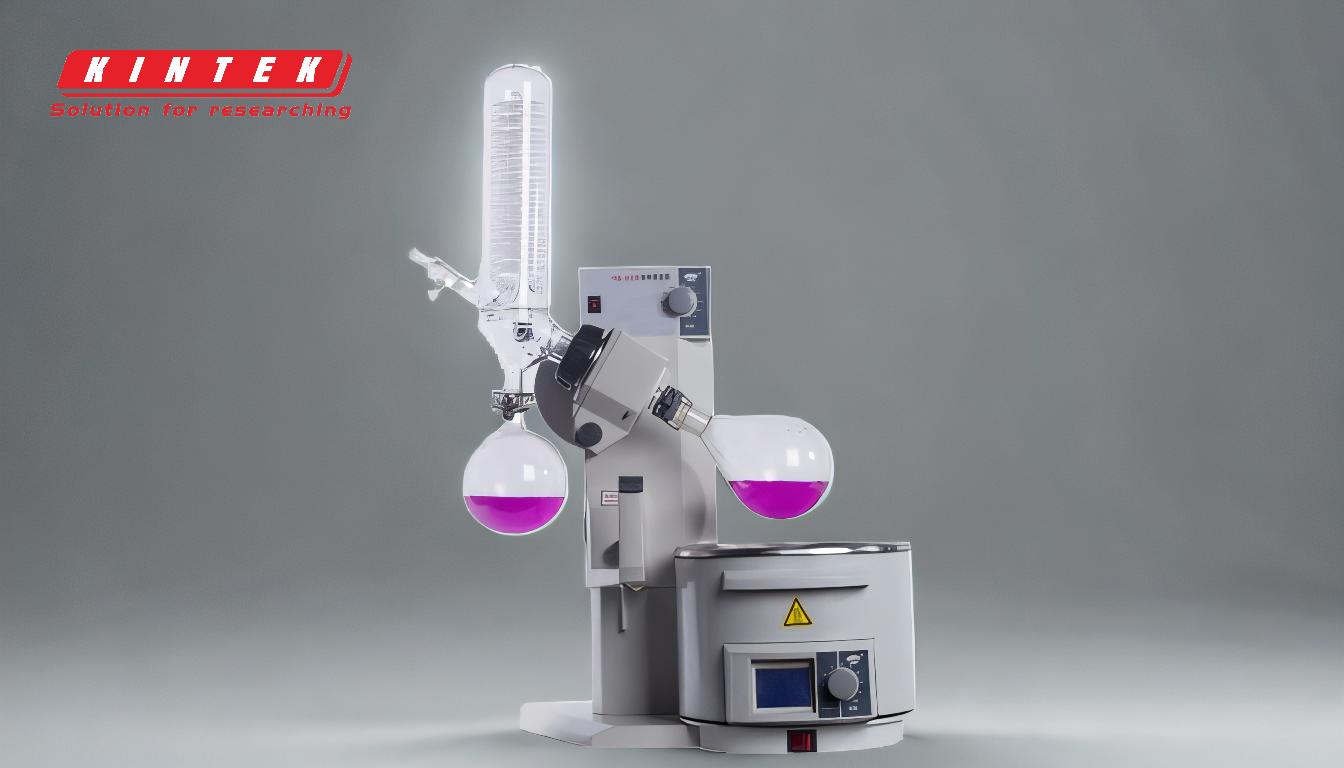In a rotary evaporator (rotovap), the solvent is initially present in the evaporation flask, where it is heated and evaporated under reduced pressure. The solvent vapors then travel through the system to the condenser, where they are cooled and re-liquefied. The condensed solvent is collected in a receiving flask located at the bottom of the condenser. This setup allows for efficient solvent recovery and reuse, making the rotovap a valuable tool in laboratories for solvent removal and recycling.
Key Points Explained:

-
Initial Location of the Solvent:
- The solvent starts in the evaporation flask, which is rotated to increase the surface area for evaporation. This flask is partially submerged in a heated water or oil bath to facilitate the evaporation process.
- Purpose: The rotation and heating help to evenly distribute heat and maximize the evaporation rate.
-
Transition to Vapor State:
- As the solvent is heated, it transitions from a liquid to a vapor state. The vacuum pump reduces the pressure inside the system, lowering the boiling point of the solvent and allowing it to evaporate at a lower temperature.
- Purpose: Lowering the pressure ensures that the solvent can be evaporated gently, which is particularly important for heat-sensitive compounds.
-
Movement Through the System:
- The solvent vapors move through the vapor duct or glass tube towards the condenser. This pathway is designed to ensure that the vapors are efficiently transported without loss.
- Purpose: The design minimizes the risk of solvent loss and ensures that the vapors reach the condenser for re-liquefaction.
-
Condensation Process:
- In the condenser, the solvent vapors are cooled, typically by a cold finger or a cooling coil, which rapidly reduces the temperature of the vapors, causing them to condense back into a liquid state.
- Purpose: Condensation is crucial for recovering the solvent in a usable form, allowing for its reuse or proper disposal.
-
Collection of the Solvent:
- The condensed solvent is collected in the receiving flask, which is positioned at the bottom of the condenser. This flask is designed to securely hold the recovered solvent.
- Purpose: The receiving flask makes it easy to collect and store the solvent, facilitating its reuse in subsequent experiments or processes.
-
System Components and Their Roles:
- Rotary Motor: Rotates the evaporation flask to increase the surface area and ensure even heating.
- Vacuum Source: Creates a vacuum to reduce pressure, enabling evaporation at lower temperatures.
- Heating Bath: Provides the necessary heat to evaporate the solvent.
- Condenser: Cools the solvent vapors, turning them back into liquid.
- Receiving Flask: Collects the condensed solvent for reuse or disposal.
- Purpose: Each component plays a critical role in the efficient and safe operation of the rotary evaporator.
-
Advantages of Solvent Recovery:
- The ability to recover and reuse solvents is a significant advantage of using a rotovap. This not only reduces waste but also lowers the cost of purchasing new solvents.
- Purpose: Solvent recovery is environmentally friendly and cost-effective, making it a preferred method in many laboratory settings.
By understanding the location and movement of the solvent within the rotary evaporator, users can better appreciate the efficiency and functionality of this essential laboratory equipment. The step-by-step process ensures that solvents are effectively removed from samples and recovered for future use, highlighting the rotovap's role in sustainable laboratory practices.
Summary Table:
| Step | Description | Purpose |
|---|---|---|
| Initial Location | Solvent starts in the evaporation flask, heated and rotated for evaporation. | Maximizes surface area and ensures even heating for efficient evaporation. |
| Transition to Vapor | Solvent evaporates under reduced pressure created by a vacuum pump. | Lowers boiling point, ideal for heat-sensitive compounds. |
| Movement Through System | Vapors travel through the vapor duct to the condenser. | Minimizes solvent loss and ensures efficient transport. |
| Condensation | Vapors are cooled in the condenser, turning back into liquid. | Recovers solvent in a usable form for reuse or disposal. |
| Collection | Condensed solvent is collected in the receiving flask. | Facilitates easy collection and storage for future use. |
| Advantages | Solvent recovery reduces waste and lowers costs. | Environmentally friendly and cost-effective for labs. |
Discover how a rotary evaporator can optimize your lab's solvent recovery—contact our experts today!











